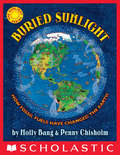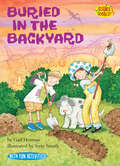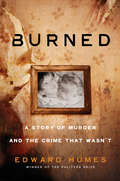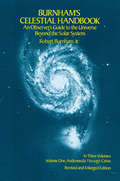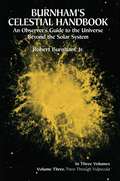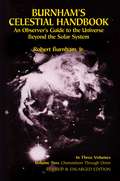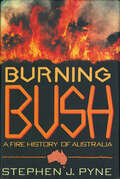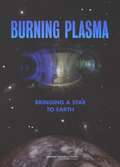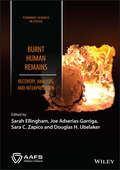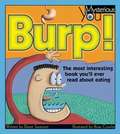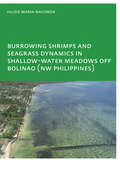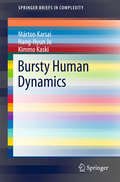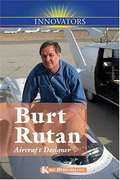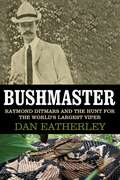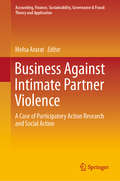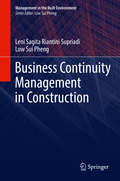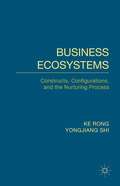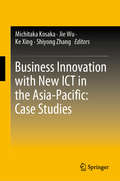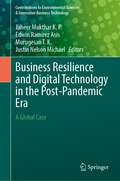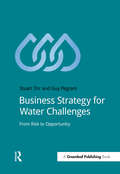- Table View
- List View
Buried Sunlight: How Fossil Fuels Have Changed the Earth
by Molly Bang Penny ChisholmAcclaimed Caldecott Artist Molly Bang teams up with award-winning M.I.T. professor Penny Chisholm to present the fascinating, timely story of fossil fuels. What are fossil fuels, and how did they come to exist? This engaging, stunning book explains how coal, oil, and gas are really "buried sunlight," trapped beneath the surface of our planet for millions and millions of years. Now, in a very short time, we are digging them up and burning them, changing the carbon balance of our planet's air and water. What does this mean, and what should we do about it? Using simple language and breathtaking paintings, Bang and Chisholm present a clear, concise explanation of the fossil-fuel energy cycle that began with the sun and now runs most of our transportation and energy use in our world. Readers will be mesmerized by this engaging fourth book in the award-winning Sunlight Series by Bang and Chisholm.
Buried in the Backyard (Science Solves It!)
by Gail HermanSolve kid-sized dilemmas and mysteries with the Science Solves It! series. These fun science books for kids ages 5–8 blend clever stories with real-life science. Why did the dog turn green? Can you control a hiccup? Is that a UFO? Find the answers to these questions and more as kid characters dive into physical, life, and earth sciences. While trying to dig a pool for themselves, Ryan and Kate discover a very large, old bone-right in their own backyard! Amazingly, it turns out to be the fossilized bone of a Woolly Mammoth! Books in this perfect STEM series will help kids think like scientists and get ahead in the classroom. Activities and experiments are included in every book! (Level One; Science topic: Woolly Mammoths)
Burned: A Story of Murder and the Crime That Wasn't
by Edward HumesWas a monstrous killer brought to justice or an innocent mother condemned?On an April night in 1989, Jo Ann Parks survived a house fire that claimed the lives of her three small children. Though the fire at first seemed a tragic accident, investigators soon reported finding evidence proving that Parks had sabotaged wiring, set several fires herself, and even barricade her four-year-old son inside a closet to prevent his escape. Though she insisted she did nothing wrong, Jo Ann parks received a life sentence without parole based on the power of forensic fire science that convincingly proved her guilt.But more than a quarter century later, a revolution in the science of fire has exposed many of the incontrovertible truths of 1989 as guesswork in disguise. The California Innocence Project is challenging Parks's conviction and the so-called science behind it, claiming that false assumptions and outright bias convicted an innocent mother of a crime that never actually happened.If Parks is exonerated, she could well be the "Patient Zero" in an epidemic of overturned guilty verdicts--but only if she wins. Can prosecutors dredge up enough evidence and roadblocks to make sure Jo Ann Parks dies in prison? No matter how her last-ditch effort for freedom turns out, the scenes of betrayal, ruin, and hope will leave readers longing for justice we can trust.
Burnham's Celestial Handbook, Volume One: An Observer's Guide to the Universe Beyond the Solar System (Dover Books on Astronomy #1)
by Robert Burnham Jr.While there are many books on stars, there is only one Celestial Handbook. Now completely revised through 1977, this unique and necessary reference is available once again to guide amateur and advanced astronomers in their knowledge and enjoyment of the stars.Volume I of this comprehensive three-part guide to the thousands of celestial objects outside our solar system ranges from Andromeda through Cetus. Objects are grouped according to constellation, and their definitions feature names, coordinates, classifications, and physical descriptions. After an extensive introduction in Volume I, which gives the beginner enough information to follow about 80 percent of the body of the material, the author gives comprehensive coverage to the thousands of celestial objects outside our solar system that are within the range of telescopes in the two- to twelve-inch range.The objects are grouped according to the constellations in which they appear. Each constellation is divided into four subject sections: list of double and multiple stars; list of variable stars; list of star clusters, nebulae and galaxies; and descriptive notes. For each object the author gives names, celestial coordinates, classification, and full physical description. These, together with a star atlas, will help you find and identify almost every object of interest.But the joy of the book is the descriptive notes that follow. They cover history, unusual movements or appearance, and currently accepted explanations of such visible phenomena as white dwarfs, novae and super novae, cepheids, mira-type variables, dark nebulae, gaseous nebulae, eclipsing binary stars, the large Magellanic cloud, the evolution of a star cluster, and hundreds of other topics, many of which are difficult to find in one place. Hundreds of charts and other visual aids are included to help in identification. Over 300 photographs capture the objects and are works of beauty that reflect the enthusiasm that star gazers have for their subject.Robert Burnham, Jr., who was on the staff of the Lowell Observatory, Flagstaff, Arizona, conceived the idea of The Celestial Handbook decades ago, when he began assembling a notebook of all the major facts published about each celestial object. In its former, privately printed edition, this handbook was acclaimed as one of the most helpful books for astronomers on any level.
Burnham's Celestial Handbook, Volume Three: An Observer's Guide to the Universe Beyond the Solar System (Dover Books on Astronomy #3)
by Robert Burnham Jr.Volume III of a comprehensive three-part guide to celestial objects outside our solar system concludes with listings from Pavo to Vulpecula. While there are many books on stars, there is only one Celestial Handbook. Now completely revised through 1977, this unique and necessary reference is available once again to guide amateur and advanced astronomers in their knowledge and enjoyment of the stars.After an extensive introduction in Volume I, which gives the beginner enough information to follow about 80 percent of the body of the material, the author gives comprehensive coverage to the thousands of celestial objects outside our solar system that are within the range of telescopes in the two- to twelve-inch range.The objects are grouped according to the constellations in which they appear. Each constellation is divided into four subject sections: list of double and multiple stars; list of variable stars; list of star clusters, nebulae and galaxies; and descriptive notes. For each object the author gives names, celestial coordinates, classification, and full physical description. These, together with a star atlas, will help you find and identify almost every object of interest.But the joy of the book is the descriptive notes that follow. They cover history, unusual movements or appearance, and currently accepted explanations of such visible phenomena as white dwarfs, novae and super novae, cepheids, mira-type variables, dark nebulae, gaseous nebulae, eclipsing binary stars, the large Magellanic cloud, the evolution of a star cluster, and hundreds of other topics, many of which are difficult to find in one place. Hundreds of charts and other visual aids are included to help in identification. Over 300 photographs capture the objects and are works of beauty that reflect the enthusiasm that star gazers have for their subject.Robert Burnham, Jr., who was on the staff of the Lowell Observatory, Flagstaff, Arizona, conceived the idea of The Celestial Handbook decades ago, when he began assembling a notebook of all the major facts published about each celestial object. In its former, privately printed edition, this handbook was acclaimed as one of the most helpful books for astronomers on any level.
Burnham's Celestial Handbook: An Observer's Guide to the Universe Beyond the Solar System (Chameleon Through Orion #Volume Two)
by Robert Burnham Jr.Chamaeleon Through OrionWhile there are many books on stars, there is only one Celestial Handbook. Now completely revised through 1977, this unique and necessary reference is available once again to guide amateur and advanced astronomers in their knowledge and enjoyment of the stars. After an extensive introduction in Volume I, which gives the beginner enough information to follow about 80 percent of the body of the material, the author gives comprehensive coverage to the thousands of celestial objects outside our solar system that are within the range of telescopes in the two- to twelve-inch range. The objects are grouped according to the constellations in which they appear. Each constellation is divided into four subject sections: list of double and multiple stars; list of variable stars; list of star clusters, nebulae, and galaxies; and descriptive notes. For each object the author gives names, celestial coordinates, classification, and full physical description. These, together with a star atlas, will help you find and identify almost every object of interest. But the joy of the book is the descriptive notes that follow. They cover history, unusual movements or appearances, and currently accepted explanations of such visible phenomena as white dwarfs, novae and supernovae, cepheids, mira-type variables, dark nebulae, gaseous nebulae, eclipsing binary stars, the large Magellanic cloud, the evolution of a star cluster, and hundreds of other topics, many of which are difficult to find in one place. Hundreds of charts and other visual aids are included to help in identification. Over 300 photographs capture the objects and, in themselves, are works of beauty that reflect the enthusiasm that star gazers have for their subject.
Burning Bush: A Fire History of Australia (Weyerhaueser Cycle Of Fire Ser.)
by Stephen J. PyneFrom the time of the continent's formation tens of millions of years ago as the Godwana twin of Antarctica, Australia has been dominated by fire much as its sister has been by ice. Now Stephen Pyne, one of our foremost environmental historians, proposes a major reinterpretation of the Australian experience by using fire and Australia to explain one another. He narrates the story of how fire came to Australia and interacted with the Australian biota and its human inhabitants, while at the same time he relates the planetary saga of fire as it has been played out on this special island continent. Much as the Aborigines exploited fire to remake their environment into something more usable, so Stephen Pyne exploits fire to transform the landscape of history into something more accessible, to use its transmuting power to extract new meaning out of familiar events. Pyne traces the impact of fire, from its initial influence on the evolving vegetation of the new continent, through its use by the Aborigines and the subsequent European settlers, to the holocaust of February 1983 known as Ash Wednesday, and he shows us that the dynamic nature of fire has made it a most powerful environmental determinant in Australia, shaping both its social and natural histories. In his critically acclaimed study of Antarctica, The Ice, Pyne explored the myriad dimensions of the cold continent; now Burning Bush offers us an equally absorbing examination of a continent informed by fire.
Burning Plasma: Bringing A Star To Earth
by Burning Plasma Assessment CommitteeSignificant advances have been made in fusion science, and a point has been reached when we need to decide if the United States is ready to begin a burning plasma experiment. A burning plasma—in which at least 50 percent of the energy to drive the fusion reaction is generated internally—is an essential step to reach the goal of fusion power generation. The Burning Plasma Assessment Committee was formed to provide advice on this decision. The committee concluded that there is high confidence in the readiness to proceed with the burning plasma step. The International Thermonuclear Experimental Reactor (ITER), with the United States as a significant partner, was the best choice. Once a commitment to ITER is made, fulfilling it should become the highest priority of the U.S. fusion research program. A funding trajectory is required that both captures the benefits of joining ITER and retains a strong scientific focus on the long-range goals of the program. Addition of the ITER project will require that the content, scope, and level of U.S. fusion activity be defined by program balancing through a priority-setting process initiated by the Office of Fusion Energy Science.
Burnt Human Remains: Recovery, Analysis, and Interpretation (Forensic Science in Focus)
by Douglas H. Ubelaker Sara C. Zapico Joe Adserias-Garriga Sarah EllinghamBURNT HUMAN REMAINS An all-encompassing reference and guide designed for professionals involved in the forensic analysis of burnt remains Burnt Human Remains: Recovery, Analysis and Interpretation presents an in-depth multidisciplinary approach to the detection, recovery, analysis, and identification of thermally altered remains. Bridging the gap between research and practice, this invaluable one-stop reference provides detailed coverage of analytical techniques in forensic medicine and pathology, forensic anthropology, forensic odontology, and forensic chemistry and forensic biology. Contributions from a panel of expert authors review the newest findings in forensics research and discuss their applicability to forensic case work. Opening with a historical overview of the discipline, the book covers the search and recovery aspects of burnt human remains, medico-legal investigations, determination of the post mortem interval of burnt remains, structural changes of burnt bone and teeth, DNA extraction from burnt remains, and much more. Throughout the text, the authors emphasize the importance of understanding the changes undergone by bodies when subjected to fire for establishing identity, reconstructing the events leading up to incineration, and determining the cause and manner of death. Provides a systemic framework that integrates established forensic methods and state-of-the-art analytical approaches Describes different forensic analyses from the macroscopical, microscopical, biochemical, and molecular level Features international case studies of challenging individual cases as well as natural or man-made mass fatalities requiring the identification of incinerated remains Demonstrates how changes to the macro- and microstructure of burnt remains can reveal information about incineration conditions Discusses organizations and programs focused on developing standards and best practice for the recovery and analysis burnt remains Burnt Human Remains: Recovery, Analysis and Interpretation is an indispensable resource for all practitioners engaged in the interpretation of burned human tissue, including pathologists, forensic chemists, forensic biologists, forensic anthropologists, forensic odontologists, and archaeologists.
Burp!: The Most Interesting Book You'll Ever Read about Eating (Mysterious You)
by Diane Swanson Rose Cowles<p>The unique Mysterious You series explores the mysteries of the human body using an exciting mix of thoroughly researched information, amazing anecdotes and surprising try-it activities. <p>In Burp!, kids discover all kinds of fascinating facts about food and eating, such as what food is made of, how your body breaks it down, why you have cravings, how sight and smell affect what you taste and lots more.</p>
Burrowing Shrimps and Seagrass Dynamics in Shallow-Water Meadows off Bolinao (New Philippines): UNESCO-IHE PhD
by Hildie Maria NacordaBased on research in Bolinao, this book assesses the importance of small-scale disturbance by burrowing shrimps. It covers the distribution of burrowing shrimp disturbance, the behavior of the snapping shrimp Alpheus macellarius in situ and as observed from tank experiments, and the effects of short-term burial and leaf clipping on the growth patte
Bursts: The Hidden Patterns Behind Everything We Do, from Your E-mail to Bloody Crusades
by Albert-Laszlo BarabasiA revolutionary new theory showing how we can predict human behavior-from a radical genius and bestselling author Can we scientifically predict our future? Scientists and pseudo scientists have been pursuing this mystery for hundreds and perhaps thousands of years. But now, astonishing new research is revealing patterns in human behavior previously thought to be purely random. Precise, orderly, predictable patterns... Albert Laszlo Barabasi, already the world's preeminent researcher on the science of networks, describes his work on this profound mystery in Bursts, a stunningly original investigation into human nature. His approach relies on the digital reality of our world, from mobile phones to the Internet and email, because it has turned society into a huge research laboratory. All those electronic trails of time stamped texts, voicemails, and internet searches add up to a previously unavailable massive data set of statistics that track our movements, our decisions, our lives. Analysis of these trails is offering deep insights into the rhythm of how we do everything. His finding? We work and fight and play in short flourishes of activity followed by next to nothing. The pattern isn't random, it's "bursty." Randomness does not rule our lives in the way scientists have assumed up until now. Illustrating this revolutionary science, Barabasi artfully weaves together the story of a 16th century burst of human activity-a bloody medieval crusade launched in his homeland, Transylvania-with the modern tale of a contemporary artist hunted by the FBI through our post 9/11 surveillance society. These narratives illustrate how predicting human behavior has long been the obsession, sometimes the duty, of those in power. Barabási's astonishingly wide range of examples from seemingly unrelated areas include how dollar bills move around the U.S., the pattern everyone follows in writing email, the spread of epidemics, and even the flight patterns of albatross. In all these phenomena a virtually identical, mathematically described bursty pattern emerges. Bursts reveals what this amazing new research is showing us about where individual spontaneity ends and predictability in human behavior begins. The way you think about your own potential to do something truly extraordinary will never be the same.
Bursty Human Dynamics (SpringerBriefs in Complexity)
by Márton Karsai Hang-Hyun Jo Kimmo KaskiThis book provides a comprehensive overview on emergent bursty patterns in the dynamics of human behaviour. It presents common and alternative understanding of the investigated phenomena, and points out open questions worthy of further investigations. The book is structured as follows. In the introduction the authors discuss the motivation of the field, describe bursty phenomena in case of human behaviour, and relate it to other disciplines. The second chapter addresses the measures commonly used to characterise heterogeneous signals, bursty human dynamics, temporal paths, and correlated behaviour. These definitions are first introduced to set the basis for the discussion of the third chapter about the observations of bursty human patterns in the dynamics of individuals, dyadic interactions, and collective behaviour. The subsequent fourth chapter discusses the models of bursty human dynamics. Various mechanisms have been proposed about the source of the heterogeneities in human dynamics, which leads to the introduction of conceptually different modelling approaches. The authors address all of these perspectives objectively, highlight their strengths and shortcomings, and mention possible extensions to them. The fifth chapter addresses the effect of individual heterogeneous behaviour on collective dynamics. This question in particular has been investigated in various systems including spreading phenomena, random walks, and opinion formation dynamics. Here the main issues are whether burstiness speeds up or slows down the co-evolving processes, and how burstiness modifies time-dependent paths in the system that determine the spreading patterns of any kind of information or influence. Finally in the sixth chapter the authors end the review with a discussion and future perspectives. It is an ideal book for researchers and students who wish to enter the field of bursty human dynamics or want to expand their knowledge on such phenomena.
Burt Rutan: Aircraft Designer (Innovators)
by Kris HirschmannA short fact-filled biography of Burt Rutan, an aviation designer known for dreaming up unusual aircraft designs and then building them. Rutan single-handedly changed the field of aviation design, and in 2004 won a ten million dollar contest for successfully designing, building and flying the first working private spaceship.
Bushmaster: Raymond Ditmars and the Hunt for the World's Largest Viper
by Dan EatherleyThe amazing story of one man’s obsession with an enigmatic and deadly reptile. Raymond Ditmars (1876-1942), the first curator of reptiles at New York’s famous Bronx Zoo, brought cold-blooded animals to public attention as never before. Through wildly successful books and movies, he inspired a generation of zoologists with his fascination for snakes, insects, and other misunderstood creatures. Ditmars was among the most celebrated naturalists in America. His reptile-collecting trips for the zoo spawned newspaper headlines across the world. Although a serpent lover, he was all too aware of the devastating effects of snakebites and was instrumental in the development of antivenom. His films and writings brought him fame, but he remained a devoted zoo employee, doing what he loved most: caring for animals. Bushmaster tells the story of this remarkable man and what became an obsession with the mysterious bushmaster of the South American rainforest. Measuring up to thirteen feet in length, this is the world’s largest viper, and its scientific name, Lachesis muta, translates as "silent fate. ” Despite numerous expeditions to jungles from Honduras to Brazil, Ditmars could never capture a bushmaster for himself. Now, British author Dan Eatherley follows in Ditmars’s footsteps, revisiting his early haunts in the United States and South America. He attempts to do what Ditmars himself failed to achieve: to find a bushmaster in the wild. But eighty years later, will Dan have any more luck? Through the author’s own quest, Bushmaster reveals the life of a pioneer herpetologist, wildlife filmmaker, and zoo curator.
Business Against Intimate Partner Violence: A Case of Participatory Action Research and Social Action (Accounting, Finance, Sustainability, Governance & Fraud: Theory and Application)
by Melsa AraratThis book addresses the Business Against Domestic Violence (BADV) project launched by the Corporate Governance Forum of Turkey (CGFT), a research center at Sabanci University School of Management. The goal of BADV is to mobilize companies to combat intimate partner violence (IPV) in Turkey. The project was made possible by a collaborative partnership with the United Nations Population Fund (UNFPA) and the Turkish Industrialists and Business Association (TUSIAD). The book is divided into two sections. Section 1, which focuses on the project itself, frames the elimination of IPV as an SDG target, and provides a detailed account of the project’s motivation, underlying research, project organization, implementation, and outcome. The question of why gender equality and IPV matter for business is also addressed. Lastly, the role of business schools and management scholars in creating practical and actionable knowledge to achieve development goals is discussed, based on the BADV experience. In turn, Section 2 explores the background of the project and sheds a multidisciplinary light on the local context. The main objective of the book is to encourage business schools and business organizations to form partnerships in pursuit of Goal-5 and other SDG targets, helping to create actionable knowledge and prompt social action. The book presents IPV from all relevant perspectives and focuses on Turkey, a key emerging economy and G-20 country.
Business Analytics: The Art of Modeling with Spreadsheets
by Kenneth R. Baker Stephen G. PowellNow in its fifth edition, Powell and Bakers Business Analytics: The Art of Modeling with Spreadsheets provides students and business analysts with the technical knowledge and skill needed to develop real expertise in business modeling. In this book, the authors cover spreadsheet engineering, management science, and the modeling craft. The briefness & accessibility of this title offers opportunities to integrate other materials -such as cases -into the course. It can be used in any number of courses or departments where modeling is a key skill.
Business Chemistry: How to Build and Sustain Thriving Businesses in the Chemical Industry
by Jens Leker Carsten Gelhard Stephan Von DelftBusiness Chemistry: How to Build and Sustain Thriving Businesses in the Chemical Industry is a concise text aimed at chemists, other natural scientists, and engineers who want to develop essential management skills. Written in an accessible style with the needs of managers in mind, this book provides an introduction to essential management theory, models, and practical tools relevant to the chemical industry and associated branches such as pharmaceuticals and consumer goods. Drawing on first-hand management experience and in-depth research projects, the authors of this book outline the key topics to build and sustain businesses in the chemical industry. The book addresses important topics such as strategy and new business development, describes global trends that shape chemical companies, and looks at recent issues such as business model innovation.
Business Continuity Management in Construction (Management in the Built Environment)
by Low Sui Pheng Leni Sagita Riantini SupriadiThis book provides an understanding of Business Continuity Management (BCM) implementation for local/international construction operations, with a primary focus on Indonesian construction firms as an illustrative example. It reviews the whole spectrum of work relating to organizational culture (OC) and the institutional framework (IF) as one of the key ways for companies to evaluate and implement BCM in construction operations. Once readers have acquired a sound understanding of BCM, OC and IF linkages in construction firms, the lessons learned can be extended to other companies. This is facilitated through a systematic assessment framework presented in the book using a Knowledge Based Decision Support System (BCM-KBDSS), which allows these companies to evaluate their current status quo with respect to BCM, OC and IF, and then make informed decisions on how and to what extent BCM should be implemented in their operations. As such, the book offers a unique blend of theory and practice, ensuring readers gain a far better understanding of BCM implementation in the construction industry.
Business Ecosystems
by Ke Rong Yongjiang ShiThe book examines business ecosystems in an emerging industry context whilst exploring four essential areas of business ecosystems: the business ecosystems' key constructive elements, their typical patterns of the element configurations, the five phase process of their life cycle, and the nurturing strategies and processes from a firm perspective.
Business Ecosystems
by Ke Rong Yongjiang ShiThe book examines business ecosystems in an emerging industry context whilst exploring four essential areas of business ecosystems: the business ecosystems' key constructive elements, their typical patterns of the element configurations, the five phase process of their life cycle, and the nurturing strategies and processes from a firm perspective.
Business Innovation with New ICT in the Asia-Pacific: Case Studies
by Ke Xing Shiyong Zhang Jie Wu Michitaka KosakaThis book clarifies the direction of business innovation using new ICT such as the Internet of things (IoT), artificial intelligence (AI), smartphones, and cloud computing through a series of case studies on successful trials and advanced businesses in the Asia-Pacific where many industry sectors have been growing successfully in the 21st century. ICT has been playing an important role in value creation for customers and in profit generation for providers, contributing to various service innovation and business innovation. Now, digitalization using IoT and AI provides solutions to address various issues in the human society, which is transforming services and businesses in the 21st century. “What is the direction of the business innovation using new ICT?” is a highly concerned question for business researchers and practitioners. Aiming to answer the question, this book conducts a number of cases studies in the Asia-Pacific region, including the Mainland China, Taiwan, Japan, Malaysia, Vietnam, as well as Australia. Among the studies, there are 4 cases from ICT providers, 4 cases from traditional and services, and 6 cases from new ICT applications and businesses. Each case analyzes social needs and human desires, new value created, roles of new technologies, processes and difficulties in developing new businesses, the relationship among customers, providers, and stakeholders, value chain co-creation and optimization, factors of success, and business models. Finally, the direction of business innovation with new ICT in the Asia-Pacific is suggested by summarizing the findings from the case studies through the lens of the theoretical analysis in service science.
Business Models for the Circular Economy: A European Perspective (Sustainability and Innovation)
by Jan Stejskal Jens Horbach Wolfgang Gerstlberger Viktor ProkopIncreased ecological awareness and the growing scarcity of resources have led to the introduction of new environmental standards, triggering enterprises, regions, and even countries to adopt new business models and industrial reconversion approaches. However, despite increased interest in business models and their innovation, it still lacks the integration of circularity and sustainability and to date research on these areas is still limited. This book, therefore, provides readers with a closer picture of the issues of business models and their innovation for the circular economy in Europe, where the issues of sustainability and the shift towards the circular economy have become cornerstones of European policies and documents and where significant differences have been identified between firms and countries. This book provides a unique view of different European perspectives and enables the reader to compare the situation in countries with completely different historical and economic conditions as well as with different perceptions of the need for the actions leading to the sustainable development and to the shift towards the circular economy.
Business Resilience and Digital Technology in the Post-Pandemic Era: A Global Case (Contributions to Environmental Sciences & Innovative Business Technology)
by Edwin Ramirez Asis Jaheer Mukthar K.P. Murugesan T. K. Justin Nelson MichaelThis book throws a light on sustainable perspectives of how business entities experienced the turbulent environment in the light of pandemic. The post-pandemic era is characterized by the radical and dramatic changes in the business model, corporate strategies and digital technology. This book provides the academicians, research scholars and corporate professionals with a thought-provoking forum to discuss and deliberate the major trends, opportunities and issues of business entity from the outlook of business resilience, corporate strategy and digital technology in the light of post-pandemic era. The book also suggests suitable measures and strategies for the sustainable development of business entities.
Business Strategy for Water Challenges: From Risk to Opportunity (Doshorts Ser.)
by Stuart Orr Guy PegramWater is a resource under increased stress, with its management now cited as one of the greatest risks to business continuity and growth. This concise guide for professionals offers strategic steps for developing a corporate water stewardship strategy. It will enable you to: define business water risks, and the opportunities associated with those risks; explore, through sector-specific profiles, risks associated with regulation, reputation, external response and engagement, and physical incidents; develop a clear plan and process for creating, managing and mainstreaming a corporate water strategy; identify several initiatives and new risk tools that your company can use to stay on top of best practice in water management. With the advent of risk tools, and a growing list of testaments around business risk from water, we are now able to respond more appropriately to how this resource is impacted by and impacts upon business. Use this book as your guide as you begin to build your company's strategy around water.
